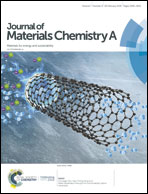Embedding CoO nanoparticles in a yolk–shell N-doped porous carbon support for ultrahigh and stable lithium storage†
Abstract
Despite great progress, the development of anode materials with excellent properties for high-performance lithium-ion batteries (LIBs) remains challenging. Rational design and synthesis of novel hybrid nanomaterials that synergistically integrate the structural/compositional advantages of their components provides exciting opportunities and solutions. Here, we demonstrate a dilute atmosphere pyrolysis strategy for the one-step synthesis of a new hybrid nanomaterial, CoO/C yolk–shell nanostructures (CoO/C YSNSs), from a Co-containing metal–organic framework precursor, ZIF-67. The CoO/C YSNSs integrate CoO and carbon into a unique hierarchical and quasi-homostructural architecture, in which both the yolk and shell comprise ultrafine CoO nanoparticles homogeneously embedded in highly porous, conductive and N-doped carbon. Benefiting from such structural and compositional features, CoO/C YSNSs deliver ultrahigh and stable lithium storage performances (retained capacity up to 1970 and 680 mA h g−1 even after 1000 charge/discharge cycles at a current density of 100 and 1000 mA g−1, respectively), and rank among the best cobalt oxide-based anode materials. The formation of CoO/C YSNSs is also investigated and attributed to two synergistic processes of dynamic redox competition and heterogeneous contraction. Our work provides new stimuli to the development of complex hybrid nanostructure-based advanced electrode materials for high-performance batteries.



 Please wait while we load your content...
Please wait while we load your content...